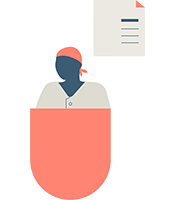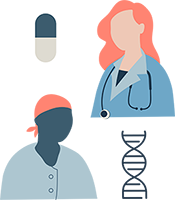
It’s hard to believe, but electronic health records (EHRs) have been around since making their debut in the 1960s and are now used by a remarkable 96% of hospitals and 86% of physician offices.1, 2 What’s even more amazing is that with all of our advances in technology, we’re only just beginning to scratch the surface of what a specialized, oncology EHR means to the future of cancer care.
When it comes to advancing EHR design to create a better experience for both providers and patients, there are three key drivers that are the basis for every decision we make.
 1. Focus on personalized medicine
1. Focus on personalized medicine
EHRs help providers identify appropriate therapy options for their patients – but the guidelines that support these decisions have historically been based off data from a generalized population. With an industry shift toward biomarker testing to build detailed patient profiles, there is an opportunity for EHRs to present an analysis of data and outcomes from more specific populations. Incorporating precise real-world evidence representing diverse patient populations and specific variables at the point of decision making will lead to more effective therapy selection and improved outcomes.
 2. Present insights at the point of need
2. Present insights at the point of need
Because EHRs were not initially built with the provider workflow as the primary process to enhance, they can be cumbersome for providers and add strain to their operations. The future state of EHRs should better support the entirety of the care experience, for both providers and patients. Instead of a provider having to look in several different places for a single piece of information, EHRs should evolve so that relevant insights are presented at the point of need. To do this, evidence-driven clinical decision support tools and algorithms should be built in ways that match provider workflows.
 3. Support shared decision making
3. Support shared decision making
Because the patient is at the center of virtually every healthcare interaction, we’re embracing the increased importance of shared decision making between patient and provider. When a patient’s values are incorporated into his or her care, the relationship between patient and provider is stronger, and often, outcomes are better. EHRs present an opportunity to make shared decision making a more seamless experience by allowing for a two-way dialogue and exchange of information and experiences. In a clinical setting, there is an opportunity for a “turn the screen moment”, in which a provider can show a patient the implications and tradeoffs of selecting one regimen versus another. And as more real-world data is collected, there is also an opportunity for an EHR to incorporate visualizations of that data that can help illustrate complex insights so that both the provider and patient can select an appropriate path forward together.
At Ontada, we are optimistic about the future of cancer care and are passionate about continually improving our technologies so that we can transform the fight against cancer.
Sources
1A history of EHRs: 10 things to know. (2015, February 16).
2 Glaser, J. (2020, October 26). It's Time for a New Kind of Electronic Health Record.